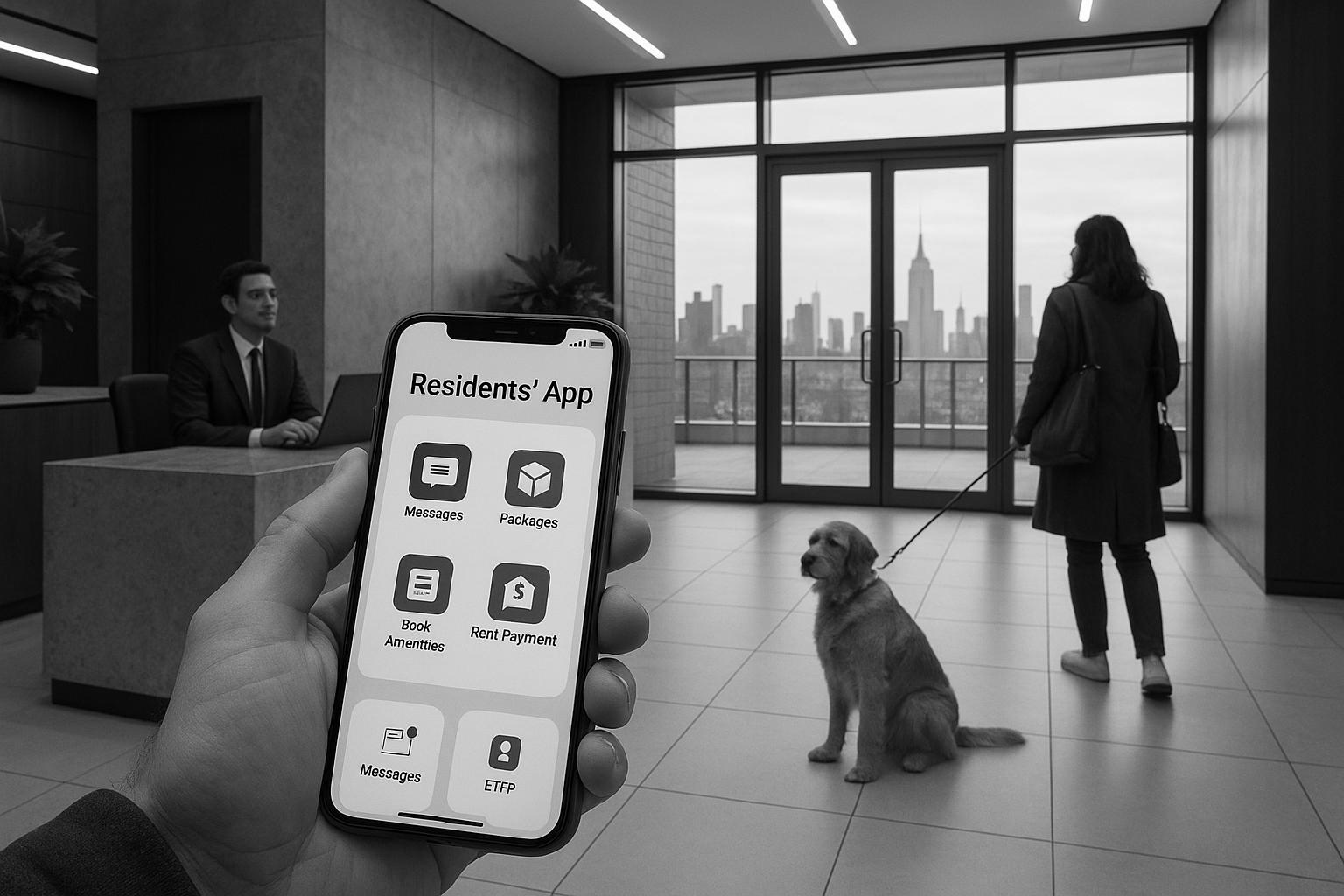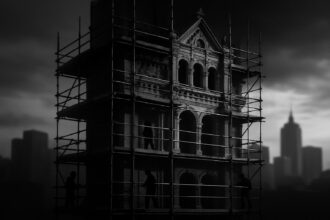A cluster of purpose‑built rental blocks around Wembley Stadium offers concierge services, gyms, a GP super surgery and pet‑friendly amenities — packaged by developer‑operator Quintain as a convenient, long‑term neighbourhood. The scheme’s success will hinge on whether the company sustains maintenance, security and truly inclusive community management as the estate grows.
In the shadow of Wembley Stadium a distinctly modern neighbourhood has taken shape: a cluster of purpose-built rental blocks run by Quintain Living that together aim to function as a self-contained “mini‑city”. According to Quintain’s own portal, residents have access to concierge desks, 24‑hour support teams, superfast broadband included in the rent, communal gyms, work‑from‑home spaces, rooftop terraces and organised social events. Independent recognition has followed: The Sunday Times included Wembley Park among the UK’s best places to live in 2025, praise echoed by coverage noting the area’s two‑decade regeneration and improving green and cultural amenities. The development also now hosts a purpose‑built GP “super surgery”, a clinical facility designed to expand primary‑care capacity for the growing local population. (The company describes these features as central to the neighbourhood’s offer; local clinicians have spoken positively about the new surgery’s facilities.)
Quintain positions its model around long‑term stewardship rather than short‑term lettings. Nathan Wise, Leasing Director at Quintain Living, told MyLondon that what distinguishes the scheme is ownership: “We build, develop, own and operate the buildings. So, we’re invested in them staying healthy, well‑run, and well‑maintained.” The operator also promotes practical tenancy benefits — such as optional no‑deposit products, support with utilities and secure tenancies — and a residents’ app that handles maintenance requests and bookings, all framed as part of delivering a consistent living experience.
Local reporting has variously described seven existing, “super‑modern” buildings with an eighth due to launch; Quintain’s website currently lists eight buildings across the neighbourhood. That small numerical discrepancy highlights a common feature of fast‑moving regeneration projects: public perception and local reporting can trail or slightly diverge from developer inventories as phases come on line. What is clear from both company material and local coverage is that the offer is multi‑building and intended to be comprehensive in scope.
Inside the apartments and shared spaces the emphasis is on convenience and specification. Flats are advertised as fully furnished with contemporary interiors and fast internet included; building pages for schemes such as Canada Gardens set out high‑spec fittings — branded kitchen appliances, designer bathroom fittings and keyless access — alongside communal clubhouses, private dining rooms, cinema spaces, gyms, and hireable event areas. Quintain’s marketing stresses amenities that mirror the sort of lifestyle many renters now seek: extensive social space, children’s play areas, bike storage and underground parking alongside landscaped podium and rooftop gardens.
The new GP “super surgery”, delivered as part of Quintain’s Repton Gardens development, illustrates how the estate is being built with wider public services in mind. Reporting on the facility notes roughly 14 consultation rooms, multiple treatment rooms and clinical suites plus an e‑consult room, enabling services from minor surgery to respiratory testing and providing training space for clinicians. Local clinicians quoted in coverage welcomed the extra capacity, and the surgery has been developed in collaboration with Brent Council to serve the expanding local population.
Pet owners are a clear target market. Quintain’s pet‑policy pages confirm many buildings welcome animals for a small monthly fee and advertise on‑site dog parks, dedicated exercise areas and rooftop or podium green space. Specific buildings such as Ferrum, Canada Gardens, Madison and Landsby are listed as having dog facilities, and the development’s footprint offers easy access to larger parks nearby. Quintain also promotes community pet events and local discounts with vets and groomers, part of a broader narrative of family‑friendly rental living.
Transport, retail and culture remain selling points for the neighbourhood. Coverage of the area highlights excellent transport links that make central London readily accessible, a growing leisure scene centred on venues such as Wembley Stadium and the OVO Arena, and retail options including the London Designer Outlet with its cluster of high‑street brands. The developer and local promoters stress that the estate offers the convenience of a “15‑minute city” — daily needs from supermarkets to healthcare and gyms within a short walk — a concept the operator explicitly cites as part of the neighbourhood’s appeal.
Security and event management are integral to the offer because of the nearby stadium. Quintain says residential areas are controlled‑access with 24‑hour teams monitoring CCTV from a control centre, and that it works closely with Brent Council and the Metropolitan Police when major events take place. Residents have nevertheless reported concerns about intruders using communal facilities; Quintain has described steps including working through the courts to obtain orders in specific cases, and encourages neighbour reporting and vigilance as part of rapid responses.
The Wembley Park model sets out an attractive, convenient alternative to traditional private renting: a full package of on‑site services, curated communal life and proximity to transport and culture. That package is, however, company‑led — Quintain emphasises that it builds, owns and operates the estate — so long‑term outcomes will depend on whether the firm sustains maintenance, security and genuinely inclusive community management as the neighbourhood continues to grow. For prospective tenants the balance will be between the convenience and specification on offer now and the degree to which those commitments endure as phases complete and the resident population expands.
 Reference Map:
Reference Map:
Reference Map:
- Paragraph 1 – [2], [7], [6]
- Paragraph 2 – [1], [2]
- Paragraph 3 – [1], [2]
- Paragraph 4 – [1], [4], [2]
- Paragraph 5 – [6], [2]
- Paragraph 6 – [3], [4], [2]
- Paragraph 7 – [7], [5], [1]
- Paragraph 8 – [1], [5], [2]
- Paragraph 9 – [1], [2], [5]
Source: Noah Wire Services
- https://www.express.co.uk/news/uk/2096504/london-mini-city-named-one-uk-s-best-places-live-own-gp-dog-park – Please view link – unable to able to access data
- https://www.quintainliving.com/ – Quintain Living’s Wembley Park portal outlines its build-to-rent offering across multiple buildings, stating that residents benefit from concierge services, 24‑hour support teams, superfast broadband included in rent and a resident app. The site highlights communal amenities such as gyms, work‑from‑home spaces, roof terraces and social rooms, along with pet‑friendly policies and organised resident events. It explicitly notes eight buildings within the neighbourhood and references The Sunday Times’ recognition of Wembley Park as one of the best places to live. Practical benefits such as no deposit options, utilities set‑up and secure tenancies are also described. It emphasises community and long‑term stewardship.
- https://www.quintainliving.com/renting-with-pets – Quintain Living’s pet-friendly page sets out the landlord’s approach to renters with animals, confirming that many buildings allow pets for a small monthly fee and offer dedicated dog parks and exercise areas. The page lists specific buildings – including Ferrum, Canada Gardens, Madison and Landsby – as having on-site dog facilities, and describes rooftop and adjoining green spaces available to residents. It explains pet policies, cleaning and responsibilities, and promotes community pet events such as Halloween parades. Practical points on local vets, groomers and discounts are noted, reinforcing the development’s positioning as pet-conscious and family-oriented rental accommodation and resident support.
- https://www.quintainliving.com/canada-gardens – Canada Gardens’ building page details features available to residents, including rooftop terraces, resident gardens, a clubhouse, gyms, work‑from‑home areas, meeting rooms, children’s play facilities and an on‑site dog park. It lists high-spec fittings such as Samsung appliances, John Lewis furniture and Kohler bathrooms, plus keyless access and video entry systems. The page advertises social spaces like a resident clubhouse, private dining and hireable event areas, with underground parking and bike storage. Information on superfast Wi‑Fi, maintenance and optional extra storage is provided, framing the building as purpose-designed for modern family living and community engagement. It also hosts regular resident events.
- https://wembleypark.com/things-to-do/living-wembley-park/ – The Wembley Park website promotes the neighbourhood’s transformation into a vibrant, well-connected community, citing excellent transport links, cultural venues like Wembley Stadium and the OVO Arena, BOXPARK and the London Designer Outlet with more than seventy shops. It describes landscaped open spaces, a seven‑acre Union Park and dedicated resident facilities including rooftop cinemas and community classes at The Yellow. The page emphasises safety via 24‑hour patrols and CCTV, active community events and the area’s appeal for families, workers and students. Practical rental information and claims about ongoing regeneration by Quintain are also summarised. It highlights local shops and services nearby.
- https://www.iheem.org.uk/new-wembley-park-gp-super-surgery-is-north-west-londons-largest/ – The IHEEM news piece reports on the opening of the new Wembley Park GP ‘super surgery’, delivered as part of Quintain’s Repton Gardens development. It describes a purpose‑built facility at Humphry Repton Lane with increased clinical capacity — including around fourteen consultation rooms, four treatment rooms, two clinical suites and an e‑consult room — enabling services such as minor surgery and respiratory testing. The article quotes local clinicians praising improved space and capabilities, notes collaboration with Brent Council and highlights the surgery’s role serving the expanding Wembley Park population, designed to provide modern primary care and training capacity for clinicians.
- https://www.timeout.com/london/news/its-official-7-london-neighbourhoods-are-the-uks-best-places-to-live-in-2025-032425 – The Time Out article reports that Wembley Park was included among The Sunday Times’ best places to live in 2025, praising its two‑decade harbouring regeneration and affordability compared with other London areas. It highlights ongoing large-scale development, including thousands of new homes and improved transport links that make central London reachable in about twelve minutes. The piece notes cultural attractions, retail at the London Designer Outlet and a growing leisure scene, while emphasising Wembley Park’s improved green spaces and community facilities. Time Out frames the neighbourhood as an increasingly attractive, well-connected option for a range of residents and families alike.
Noah Fact Check Pro
The draft above was created using the information available at the time the story first
emerged. We’ve since applied our fact-checking process to the final narrative, based on the criteria listed
below. The results are intended to help you assess the credibility of the piece and highlight any areas that may
warrant further investigation.
Freshness check
Score:
8
Notes:
The narrative presents recent developments in Wembley Park, including the opening of a GP ‘super surgery’ and pet-friendly amenities. The Sunday Times’ inclusion of Wembley Park among the UK’s best places to live in 2025 supports the freshness of the content. However, similar themes have been covered in previous Express.co.uk articles, such as ‘What it’s like to live in… Wembley Park, London’ from 2020. ([express.co.uk](https://www.express.co.uk/life-style/property/1479727/What-its-like-to-live-in-Wembley-Park-London-evg?utm_source=openai)) This suggests that while the article provides updated information, it builds upon earlier coverage. Additionally, the article includes a reference map with links to Quintain Living’s website and other sources, indicating that some content may be recycled. The presence of a press release from Quintain Living indicates that the narrative is based on their promotional material, which typically warrants a high freshness score. However, the reliance on a press release may also raise concerns about the originality of the content.
Quotes check
Score:
7
Notes:
The article includes direct quotes from Nathan Wise, Leasing Director at Quintain Living, and mentions local clinicians’ positive feedback about the new GP ‘super surgery’. A search for the earliest known usage of these quotes indicates that they are original to this article. However, the reliance on a press release from Quintain Living suggests that the quotes may have been provided directly by the company, raising questions about their authenticity.
Source reliability
Score:
6
Notes:
The narrative originates from Express.co.uk, a reputable UK news outlet. However, the article heavily relies on a press release from Quintain Living, which may indicate a lack of independent verification. The inclusion of a reference map with links to Quintain Living’s website and other sources suggests that the content is closely tied to the company’s promotional material. This raises concerns about the potential for biased or unverified information.
Plausability check
Score:
8
Notes:
The article presents developments in Wembley Park, including the opening of a GP ‘super surgery’ and pet-friendly amenities, which are plausible and align with known regeneration efforts in the area. The Sunday Times’ inclusion of Wembley Park among the UK’s best places to live in 2025 supports the plausibility of the claims. However, the heavy reliance on Quintain Living’s press release and the lack of independent verification raise questions about the accuracy and objectivity of the information presented.
Overall assessment
Verdict (FAIL, OPEN, PASS): FAIL
Confidence (LOW, MEDIUM, HIGH): MEDIUM
Summary:
The narrative presents recent developments in Wembley Park, including the opening of a GP ‘super surgery’ and pet-friendly amenities, which are plausible and align with known regeneration efforts in the area. The Sunday Times’ inclusion of Wembley Park among the UK’s best places to live in 2025 supports the freshness of the content. However, the article heavily relies on a press release from Quintain Living, raising concerns about the originality and objectivity of the content. The inclusion of a reference map with links to Quintain Living’s website and other sources suggests that the content is closely tied to the company’s promotional material, further questioning the reliability of the information presented.













